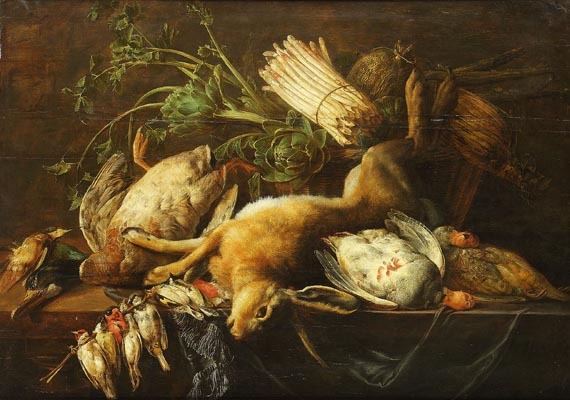
Giovanni Stanchi (Rome c. 1645-1672). Oil on canvas, 38 5/8 x 52½ in. (Christie's Images Ltd.)
Posted on 08/09/2015 8:31:31 AM PDT by afraidfortherepublic
Paintings can be a window to more than the outmoded dress and strange customs of the past — sometimes, they have modern-day science lessons to impart, too. That's the case with Giovanni Stanchi’s 17th century still life of fruit, as Phil Edwards points out for Vox — just look for the watermelons.
Stanchi’s work, painted between 1645 and 1672 (and now up for auction at Christie’s), includes strange watermelons that look so foreign they could be from outer space in the bottom right corner. If watermelons looked like that in the Renaissance, then why do they look so different today? To delve into that question, Edwards spoke to James Neihuis, a horticulturist at the University of Wisconsin.
(Excerpt) Read more at smithsonianmag.com ...

Giovanni Stanchi (Rome c. 1645-1672). Oil on canvas, 38 5/8 x 52½ in. (Christie's Images Ltd.)
ping
bttt
Watermelons had made their way to gardens in southern Europe by around 1600, writes Edwards, but they weren't domesticated by any means. For one thing, they were smaller, as most wild fruits are. They were also lighter than modern-day watermelons — the fleshy fruit surrounding the seeds is actually watermelon placenta, and it contained lower levels of lycopene, the protein that gives the fruit its red color.Over time, humans have selectively bred watermelons to grow larger and produce higher levels of lycopene, brightening their insides in the process.

Modern watermelons
Another striking thing about the Stanchi watermelons has little to do with domestication, though, writes Christopher Jobson for This is Colossal. The placenta appears divided and swirls around the seeds. That’s a phenomenon called “starring,” and it’s a product of unfriendly growing conditions in which the plant has less access to pollen.Still, Edwards notes, Stanchi’s watermelons are a reminder that looking at art from hundreds of years ago can reveal a lot about humans have molded wild plants into modern crops. In their mere difference from the watermelons available in modern-day grocery stores, the fruit points to centuries of careful breeding — and a past in which fruit looked much different from today.
Just proof that “heritege” varieties are not always better.
They’re beautiful, but too much rind and too much seed. Hybridized out of them over the centuries.
Why, the next thing you know, future generation won't be able to see a rare strain of minnow that has a stripe on its back, even though common minnows are not endangered in any way. Let us reroute all water usage through government first, to save the DNA heritage of the striped minnow for our great grandchildren!!!
Great post!
Caused by Evolution and Global Warming, no doubt.
Thanks.
I am pretty sure you can post the entire article.
We own the Smithsonian Institute.
Ack! Genetically modified food! Run for your lives.
FMCDH(BITS)
Heirloom and heritage varieties act as a genetic placeholder, and preserve the characterics of a plant at a certain point in the hybridization process, almost like a reset button or a reference marker.
Thanks afraidfortherepublic.

Well, I did. I think that I’ve been cautioned with Smithsonian before, but maybe not.
Beautiful! although I would have preferred that they were wearing period costumes and playing in a “salon” setting with the painting on the wall behind. The white church and black garments look so sterile, compared the the rich opulence of the painting.
What instrument is that keyboard? It is not a harpsichord. Do you know the name of it?
And the keyboardist — is he about 12?
I never knew that lycopene was a protein.
Disclaimer: Opinions posted on Free Republic are those of the individual posters and do not necessarily represent the opinion of Free Republic or its management. All materials posted herein are protected by copyright law and the exemption for fair use of copyrighted works.